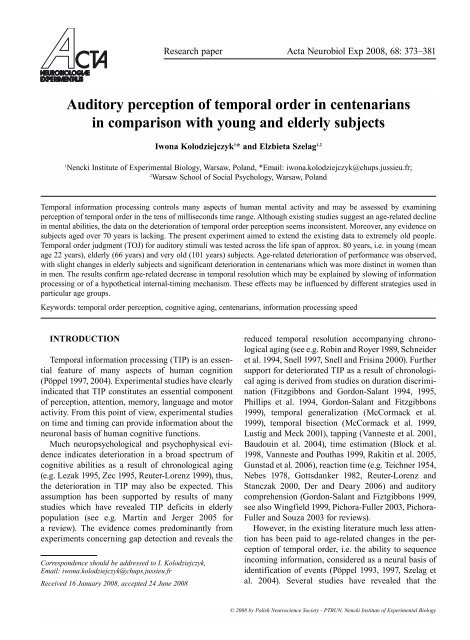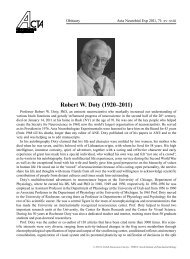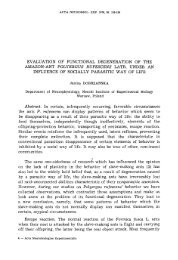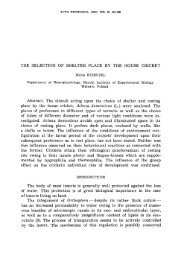Auditory perception of temporal order in centenarians in comparison ...
Auditory perception of temporal order in centenarians in comparison ...
Auditory perception of temporal order in centenarians in comparison ...
Create successful ePaper yourself
Turn your PDF publications into a flip-book with our unique Google optimized e-Paper software.
INTRODUCTION<br />
Temporal <strong>in</strong>formation process<strong>in</strong>g (TIP) is an essential<br />
feature <strong>of</strong> many aspects <strong>of</strong> human cognition<br />
(Pöppel 1997, 2004). Experimental studies have clearly<br />
<strong>in</strong>dicated that TIP constitutes an essential component<br />
<strong>of</strong> <strong>perception</strong>, attention, memory, language and motor<br />
activity. From this po<strong>in</strong>t <strong>of</strong> view, experimental studies<br />
on time and tim<strong>in</strong>g can provide <strong>in</strong>formation about the<br />
neuronal basis <strong>of</strong> human cognitive functions.<br />
Much neuropsychological and psychophysical evidence<br />
<strong>in</strong>dicates deterioration <strong>in</strong> a broad spectrum <strong>of</strong><br />
cognitive abilities as a result <strong>of</strong> chronological ag<strong>in</strong>g<br />
(e.g. Lezak 1995, Zec 1995, Reuter-Lorenz 1999), thus,<br />
the deterioration <strong>in</strong> TIP may also be expected. This<br />
assumption has been supported by results <strong>of</strong> many<br />
studies which have revealed TIP deficits <strong>in</strong> elderly<br />
population (see e.g. Mart<strong>in</strong> and Jerger 2005 for<br />
a review). The evidence comes predom<strong>in</strong>antly from<br />
experiments concern<strong>in</strong>g gap detection and reveals the<br />
Research paper Acta Neurobiol Exp 2008, 68: 373–381<br />
<strong>Auditory</strong> <strong>perception</strong> <strong>of</strong> <strong>temporal</strong> <strong>order</strong> <strong>in</strong> <strong>centenarians</strong><br />
<strong>in</strong> <strong>comparison</strong> with young and elderly subjects<br />
Iwona Kolodziejczyk 1 * and Elzbieta Szelag 1,2<br />
1 Nencki Institute <strong>of</strong> Experimental Biology, Warsaw, Poland, *Email: iwona.kolodziejczyk@chups. jussieu. fr;<br />
2 Warsaw School <strong>of</strong> Social Psychology, Warsaw, Poland<br />
Temporal <strong>in</strong>formation process<strong>in</strong>g controls many aspects <strong>of</strong> human mental activity and may be assessed by exam<strong>in</strong><strong>in</strong>g<br />
<strong>perception</strong> <strong>of</strong> <strong>temporal</strong> <strong>order</strong> <strong>in</strong> the tens <strong>of</strong> milliseconds time range. Although exist<strong>in</strong>g studies suggest an age-related decl<strong>in</strong>e<br />
<strong>in</strong> mental abilities, the data on the deterioration <strong>of</strong> <strong>temporal</strong> <strong>order</strong> <strong>perception</strong> seems <strong>in</strong>consistent. Moreover, any evidence on<br />
subjects aged over 70 years is lack<strong>in</strong>g. The present experiment aimed to extend the exist<strong>in</strong>g data to extremely old people.<br />
Temporal <strong>order</strong> judgment (TOJ) for auditory stimuli was tested across the life span <strong>of</strong> approx. 80 years, i.e. <strong>in</strong> young (mean<br />
age 22 years), elderly (66 years) and very old (101 years) subjects. Age-related deterioration <strong>of</strong> performance was observed,<br />
with slight changes <strong>in</strong> elderly subjects and significant deterioration <strong>in</strong> <strong>centenarians</strong> which was more dist<strong>in</strong>ct <strong>in</strong> women than<br />
<strong>in</strong> men. The results confirm age-related decrease <strong>in</strong> <strong>temporal</strong> resolution which may be expla<strong>in</strong>ed by slow<strong>in</strong>g <strong>of</strong> <strong>in</strong>formation<br />
process<strong>in</strong>g or <strong>of</strong> a hypothetical <strong>in</strong>ternal-tim<strong>in</strong>g mechanism. These effects may be <strong>in</strong>fluenced by different strategies used <strong>in</strong><br />
particular age groups.<br />
Keywords: <strong>temporal</strong> <strong>order</strong> <strong>perception</strong>, cognitive ag<strong>in</strong>g, <strong>centenarians</strong>, <strong>in</strong>formation process<strong>in</strong>g speed<br />
Correspondence should be addressed to I. Kolodziejczyk,<br />
Email: iwona.kolodziejczyk@chups.jussieu.fr<br />
Received 16 January 2008, accepted 24 June 2008<br />
reduced <strong>temporal</strong> resolution accompany<strong>in</strong>g chronological<br />
ag<strong>in</strong>g (see e.g. Rob<strong>in</strong> and Royer 1989, Schneider<br />
et al. 1994, Snell 1997, Snell and Fris<strong>in</strong>a 2000). Further<br />
support for deteriorated TIP as a result <strong>of</strong> chronological<br />
ag<strong>in</strong>g is derived from studies on duration discrim<strong>in</strong>ation<br />
(Fitzgibbons and Gordon-Salant 1994, 1995,<br />
Phillips et al. 1994, Gordon-Salant and Fitzgibbons<br />
1999), <strong>temporal</strong> generalization (McCormack et al.<br />
1999), <strong>temporal</strong> bisection (McCormack et al. 1999,<br />
Lustig and Meck 2001), tapp<strong>in</strong>g (Vanneste et al. 2001,<br />
Baudou<strong>in</strong> et al. 2004), time estimation (Block et al.<br />
1998, Vanneste and Pouthas 1999, Rakit<strong>in</strong> et al. 2005,<br />
Gunstad et al. 2006), reaction time (e.g. Teichner 1954,<br />
Nebes 1978, Gottsdanker 1982, Reuter-Lorenz and<br />
Stanczak 2000, Der and Deary 2006) and auditory<br />
comprehension (Gordon-Salant and Fiztgibbons 1999,<br />
see also W<strong>in</strong>gfield 1999, Pichora-Fuller 2003, Pichora-<br />
Fuller and Souza 2003 for reviews).<br />
However, <strong>in</strong> the exist<strong>in</strong>g literature much less attention<br />
has been paid to age-related changes <strong>in</strong> the <strong>perception</strong><br />
<strong>of</strong> <strong>temporal</strong> <strong>order</strong>, i.e. the ability to sequence<br />
<strong>in</strong>com<strong>in</strong>g <strong>in</strong>formation, considered as a neural basis <strong>of</strong><br />
identification <strong>of</strong> events (Pöppel 1993, 1997, Szelag et<br />
al. 2004). Several studies have revealed that the<br />
© 2008 by Polish Neuroscience Society - PTBUN, Nencki Institute <strong>of</strong> Experimental Biology
374 I. Kolodziejczyk and E. Szelag<br />
identiication <strong>of</strong> <strong>temporal</strong> <strong>order</strong> <strong>of</strong> two acoustic stimuli<br />
is only possible when they are separated by an <strong>in</strong>terstimulus<br />
<strong>in</strong>terval (ISI) <strong>of</strong> approximately 20–60 ms<br />
(Hirsh and Sherrick 1961, Mills and Rollman 1980, see<br />
also Szelag et al. 2004, Wittmann and F<strong>in</strong>k 2004 or<br />
Kiss et al. 2008 for recent reviews). This <strong>in</strong>formation<br />
supports the notion <strong>of</strong> <strong>temporal</strong>ly discrete <strong>in</strong>formation<br />
process<strong>in</strong>g <strong>in</strong> a time w<strong>in</strong>dow <strong>of</strong> some tens <strong>of</strong> milliseconds.<br />
Considerable evidence on the existence <strong>of</strong> such<br />
a <strong>temporal</strong> process<strong>in</strong>g platform has been provided by<br />
experiments us<strong>in</strong>g various paradigms (see e.g. Pöppel<br />
1997, Wittmann 1999, Szelag et al. 2001 for reviews),<br />
support<strong>in</strong>g a view <strong>of</strong> a central tim<strong>in</strong>g mechanism that<br />
controls our sequenc<strong>in</strong>g abilities (Hirsh and Sherrick<br />
1961, Güçlü and Murat 2007). However, recent studies<br />
have suggested that this mechanism may be <strong>in</strong>fluenced<br />
by many procedure and subject related factors (F<strong>in</strong>k et<br />
al. 2005, F<strong>in</strong>k et al. 2006, Szymaszek et al. 2006).<br />
Although a large amount <strong>of</strong> literature has been<br />
devoted to the <strong>perception</strong> <strong>of</strong> <strong>temporal</strong> <strong>order</strong>, only a few<br />
papers have concentrated on age-related changes <strong>in</strong><br />
this task. The hypothesis <strong>of</strong> age-related deterioration<br />
<strong>in</strong> auditory sequenc<strong>in</strong>g abilities is derived predom<strong>in</strong>antly<br />
from experiments by Fitzgibbons and Gordon-<br />
Salant (1998, Gordon-Salant and Fitzgibbons 1999)<br />
who found that deficits <strong>in</strong> <strong>temporal</strong>-<strong>order</strong> judgment<br />
(TOJ) may be <strong>in</strong>creased by the stimulus complexity,<br />
i.e. sequences conta<strong>in</strong><strong>in</strong>g bidirectional frequency<br />
shifts. These studies exam<strong>in</strong>ed the TOJ <strong>in</strong> sequences<br />
<strong>of</strong> three pure tones presented <strong>in</strong> a rapid succession<br />
without any ISI, but with adaptively varied tonal durations.<br />
In a series <strong>of</strong> experiments the authors found<br />
deficits <strong>in</strong> both identification and discrim<strong>in</strong>ation <strong>of</strong><br />
<strong>temporal</strong> <strong>order</strong> <strong>in</strong> subjects aged 65–76 years, as compared<br />
with younger subjects, aged 20–40 years, but<br />
only for the most difficult stimulus sequences.<br />
Age-related deterioration <strong>in</strong> TOJ has been also<br />
observed <strong>in</strong> the studies <strong>in</strong> which two-stimulus sequences<br />
were applied. For example, Philips and coauthors<br />
(1999) found that elderly people (aged approx. 72<br />
years) needed longer ISIs than the younger ones (aged<br />
approx. 22 years) to report correctly the <strong>temporal</strong> <strong>order</strong><br />
<strong>of</strong> illum<strong>in</strong>ation <strong>of</strong> two diodes. A similar conclusion<br />
may be drawn from experiments on auditory <strong>perception</strong><br />
(F<strong>in</strong>k et al. 2005, Szymaszek et al. 2006). In these<br />
studies two stimulus presentation modes, i.e. monaural<br />
vs. alternat<strong>in</strong>g b<strong>in</strong>aural, were applied. In the monaural<br />
presentation, two identical stimuli were presented with<br />
an ISI: one stimulus was presented to the left ear and<br />
the other to the right ear and the task was to <strong>in</strong>dicate<br />
their <strong>temporal</strong> <strong>order</strong> (i.e., ‘left-right’ or ‘right-left’). In<br />
the b<strong>in</strong>aural presentation mode, two tones <strong>of</strong> various<br />
frequencies separated by an ISI were exposed to both<br />
ears and the subject was aga<strong>in</strong> asked to <strong>in</strong>dicate their<br />
<strong>temporal</strong> <strong>order</strong> (i.e., ‘high-low’ or ‘low-high’). These<br />
two modes <strong>in</strong>volve, besides TIP, also mode-specific<br />
process<strong>in</strong>g related to different underly<strong>in</strong>g processes<br />
and mechanisms. This issue was discussed <strong>in</strong> detail <strong>in</strong><br />
our earlier report (Szymaszek et al. 2006, see the<br />
Discussion section). Briefly, we found that performance<br />
<strong>in</strong> the monaural mode was more resistant (thus<br />
less deteriorated) to subjects’ age than <strong>in</strong> the b<strong>in</strong>aural<br />
mode. For the monaural mode the deterioration was<br />
not significant when compar<strong>in</strong>g the performance <strong>of</strong><br />
young (20–29-year-olds) and elderly (60–69-year-olds)<br />
listeners with normal hear<strong>in</strong>g sensitivity. In contrast,<br />
for the b<strong>in</strong>aural mode a significant age effect was<br />
observed. Similar presentation-mode <strong>in</strong>fluences were<br />
observed by F<strong>in</strong>k and coworkers (2005).<br />
The present <strong>in</strong>vestigation extends the exist<strong>in</strong>g studies<br />
on ag<strong>in</strong>g and <strong>temporal</strong> <strong>order</strong> detection to a population<br />
<strong>of</strong> extremely old subjects, i.e. Polish <strong>centenarians</strong>.<br />
Exist<strong>in</strong>g studies on age-related changes <strong>in</strong> TOJ have<br />
concentrated on subjects up to no more than 80 years<br />
<strong>of</strong> age and any evidence <strong>in</strong> older listeners is lack<strong>in</strong>g.<br />
The present experiment is a unique <strong>in</strong>vestigation <strong>of</strong> the<br />
sequenc<strong>in</strong>g abilities across a life span <strong>of</strong> 80 years, from<br />
20 to 100 years <strong>of</strong> age. In the present study the monaural<br />
presentation mode was applied because no significant<br />
decl<strong>in</strong>e for this procedure was found <strong>in</strong> earlier<br />
reports <strong>in</strong> subjects aged up to 70 years (see above).<br />
This mode, therefore, seems more resistant to agerelated<br />
deterioration <strong>in</strong> the <strong>perception</strong> <strong>of</strong> <strong>temporal</strong><br />
<strong>order</strong>.<br />
In the exist<strong>in</strong>g literature there are some <strong>in</strong>dications<br />
that sequenc<strong>in</strong>g abilities can be also modified by subjects’<br />
gender and men <strong>of</strong>ten display better performance<br />
than women <strong>in</strong> <strong>temporal</strong> <strong>order</strong> tasks (Lotze et al. 1999,<br />
Wittmann and Szelag 2003, Szymaszek et al. 2006).<br />
Thus, <strong>in</strong> the present study we analyzed the gender<br />
effect on the performance <strong>of</strong> each age group.<br />
METHODS<br />
Subjects<br />
Forty-six volunteers without previous experience <strong>in</strong><br />
the task were <strong>in</strong>cluded and divided <strong>in</strong>to 3 age groups:
Characteristics <strong>of</strong> the three age groups<br />
young (19–25 years), elderly (65–67 years), and very<br />
old (95–103 years) adults. For detailed characteristics<br />
<strong>of</strong> each group see Table I.<br />
Subjects <strong>in</strong> the two younger groups were righthanded,<br />
as verified by the Ed<strong>in</strong>burgh Handedness<br />
Inventory (Oldfield 1971). They were screened for<br />
hear<strong>in</strong>g level for the frequencies <strong>of</strong> 250 and 500 Hz<br />
and only those whose differences <strong>in</strong> hear<strong>in</strong>g threshold<br />
between the right and the left ear were smaller than<br />
20 dB HL were <strong>in</strong>cluded <strong>in</strong> the study. None had a history<br />
<strong>of</strong> neurological dis<strong>order</strong>s or serious head <strong>in</strong>jury <strong>in</strong><br />
the past. People us<strong>in</strong>g drugs that could <strong>in</strong>fluence the<br />
nervous system, as well as those who scored below 25 th<br />
percentile <strong>in</strong> Raven Progressive Matrices (Raven<br />
1977) were not <strong>in</strong>cluded <strong>in</strong> the study. Informed, written<br />
consent was obta<strong>in</strong>ed from every subject before the<br />
experiment.<br />
The very old subjects were identified by the Polish<br />
Centenarian Project on the base <strong>of</strong> the Civil Registration<br />
System. Next, their age was verified on the basis <strong>of</strong><br />
birth certificates or any other reliable documents. As<br />
a very limited number <strong>of</strong> <strong>centenarians</strong> is cognitively<br />
<strong>in</strong>tact (see also below), from a total number <strong>of</strong> over 200<br />
recruited only 11 were <strong>in</strong>cluded <strong>in</strong> our study. These<br />
subjects were born between August 1900 and November<br />
1903 1 . All were able both to enter <strong>in</strong>to communication<br />
with the researcher and to carry out the <strong>in</strong>structions.<br />
The <strong>centenarians</strong> fulfilled similar criteria as those<br />
described above for younger people with respect to<br />
handedness and hear<strong>in</strong>g level. The very old people<br />
were screened for neurological status and neither serious<br />
neurological problems nor marked neurodegenerative<br />
diseases were found. On this basis it may be<br />
assumed that the very old subjects <strong>in</strong>cluded <strong>in</strong> the present<br />
study constituted a group <strong>of</strong> relatively healthy<br />
<strong>centenarians</strong>.<br />
1 In case <strong>of</strong> one subject (no 7) the validation <strong>of</strong> age was impossible; another (no 2)<br />
turned out to be about 95 years old.<br />
Table I<br />
Temporal <strong>order</strong> <strong>perception</strong> <strong>in</strong> <strong>centenarians</strong> 375<br />
Group n Sex (M/F) Age (years; months) Education time (years; months)<br />
Young 17 8/9 22 (± 1;11) 14;8 (± 1;11)<br />
Elderly 18 10/8 66 (± 0;7) 14;8 (± 3;1)<br />
Very old 11 6/5 101;1 (± 0;11) 6;1 (± 4;5)<br />
The <strong>centenarians</strong> scored between 17 and 27 (mean<br />
score 22) <strong>in</strong> the M<strong>in</strong>i-Mental State Exam<strong>in</strong>ation (MMSE;<br />
Folste<strong>in</strong> et al. 1975). Despite low scores on the MMSE<br />
obta<strong>in</strong>ed by some subjects (see Table II), the results <strong>of</strong><br />
this test were not treated as an exclusion criterion<br />
because normative data for such an old population is<br />
lack<strong>in</strong>g. Moreover, the low MMSE scores might have<br />
been related to the low educational level <strong>of</strong> some subjects<br />
<strong>in</strong> this group. Because <strong>of</strong> the cohort effect and<br />
important changes <strong>in</strong> the education system over generations,<br />
it would be very difficult to f<strong>in</strong>d people with such<br />
a low education <strong>in</strong> the two younger groups (see Table I).<br />
All 11 <strong>centenarians</strong> lived with their families, 4 <strong>of</strong> them<br />
(36%) <strong>in</strong> the countryside and 7 (64%) <strong>in</strong> the cities.<br />
Table II<br />
Detailed characteristics <strong>of</strong> the <strong>centenarians</strong><br />
No Age (years;<br />
months)<br />
Gender Education<br />
(years)<br />
MMSE<br />
1 100;4 M 15 20<br />
2 100;7 M 6 26<br />
3 100;4 M 13 24<br />
4 101 M 3 22<br />
5 100;6 M<br />
no<br />
<strong>in</strong>formation<br />
27<br />
6 100;8 M 5 23<br />
7 102;5 F 3 21<br />
8 101;8 F 3 17<br />
9 100;7 F 3 24<br />
10 103;2 F 3 18<br />
11 100;7 F 7 21
376 I. Kolodziejczyk and E. Szelag<br />
Procedure<br />
Subjects <strong>in</strong> the two younger groups were tested <strong>in</strong>dividually<br />
<strong>in</strong> a soundpro<strong>of</strong> room at the Nencki Institute.<br />
The very old people were tested at their homes, as the<br />
transportation to the Institute would be difficult and<br />
stressful for such old people. The very simple experimental<br />
paradigm created a relatively easy task for the<br />
very old participants.<br />
The stimuli were ‘square’ tones <strong>of</strong> 300 Hz generated<br />
by a 16-bit SoundBlaster Card and presented for 15 ms<br />
monaurally via headphones at a comfortable listen<strong>in</strong>g<br />
level. The tones were presented <strong>in</strong> pairs; each pair consisted<br />
<strong>of</strong> one tone presented to the left (L) and the other<br />
to the right (R) ear. Between the tones <strong>in</strong> each pair<br />
there was an ISI (i.e. time between the <strong>of</strong>fset <strong>of</strong> the<br />
first tone and the onset <strong>of</strong> the second one) <strong>of</strong> either 10,<br />
20, 40, 60, 80, 100, 150, 300, 500 or 1 000 ms. The<br />
subject’s task was to report the <strong>temporal</strong> <strong>order</strong> <strong>of</strong><br />
stimuli <strong>in</strong> the tone pairs (R-L vs. L-R). If the tones<br />
were perceived by the subject as simultaneous, she/he<br />
could answer ‘I do not know’ (D-n-K), however, this<br />
answer was counted as an error. Dur<strong>in</strong>g the experiment,<br />
12 presentations <strong>of</strong> each ISI were randomly<br />
<strong>order</strong>ed. Thus the experimental session consisted <strong>of</strong><br />
120 trials. The <strong>order</strong> <strong>of</strong> tones <strong>in</strong> half <strong>of</strong> the trials was<br />
R-L, whereas <strong>in</strong> the other half it was L-R. The time<br />
between the subject’s response and the presentation <strong>of</strong><br />
the first tone <strong>in</strong> the next trial was 2 s.<br />
The proper experiment was preceded by a practice<br />
session to familiarize the participants with the task. At<br />
the beg<strong>in</strong>n<strong>in</strong>g <strong>of</strong> the practice session, s<strong>in</strong>gle tones were<br />
presented and the subjects were requested to <strong>in</strong>dicate<br />
the stimulated ear. Next, they were requested to report<br />
the <strong>order</strong> <strong>of</strong> two tones presented <strong>in</strong> pairs with a constant<br />
ISI <strong>of</strong> 500 ms. If dur<strong>in</strong>g the presentation <strong>of</strong> 24<br />
consecutive trials the <strong>order</strong> <strong>of</strong> at least 20 pairs was<br />
reported correctly, the proper experiment began. In the<br />
two younger groups the experiment took approx.<br />
30 m<strong>in</strong>utes. For the <strong>centenarians</strong> it lasted about<br />
1 hour.<br />
Data elaboration and statistical analyses<br />
The analyzed variable was the <strong>temporal</strong>-<strong>order</strong><br />
threshold (TOT), def<strong>in</strong>ed as the ISI at which the probability<br />
<strong>of</strong> correct response was 75%. To calculate the<br />
TOT for each subject, the psychometric functions<br />
were fitted to his/her experimental data us<strong>in</strong>g the<br />
psignifit toolbox version 2.5.41 for Matlab (see http://<br />
bootstrap-s<strong>of</strong>tware.org/psignifit) which implements<br />
the maximum-likelihood method described by<br />
Wichmann and Hill (2001). Then, the ISI was assessed<br />
for which the psychometric function reached 75% <strong>of</strong><br />
correct responses. TOTs obta<strong>in</strong>ed by <strong>in</strong>dividual subjects<br />
were then submitted to Analysis <strong>of</strong> Variance<br />
(ANOVA). A post-hoc analysis was performed us<strong>in</strong>g<br />
the Tukey test. Moreover, the frequency <strong>of</strong> D-n-K<br />
responses was analyzed with Kruskal-Wallis and<br />
Mann-Whitney tests.<br />
RESULTS<br />
A two-way ANOVA with between-subject factors<br />
‘age’ (young, elderly and very old adults) and ‘gender’<br />
(men vs. women) showed a significant effect <strong>of</strong> ‘age’<br />
(F 2,40=44.2, P
Fig 1. The TOT values <strong>in</strong> men and women <strong>in</strong> three age<br />
groups<br />
It is known that <strong>in</strong> paper-and-pencil tests elderly<br />
people display the tendency to choose “don’t know”<br />
response more frequently than the young (Schwarz and<br />
Knäuper 1999). S<strong>in</strong>ce D-n-K responses were counted<br />
as errors, thus <strong>in</strong>fluenc<strong>in</strong>g the TOT value, another<br />
analysis was carried out to exam<strong>in</strong>e whether the number<br />
<strong>of</strong> D-n-K responses differed between groups.<br />
Significant group-differences were observed for ISIs<br />
from 10 to 300 ms (P
378 I. Kolodziejczyk and E. Szelag<br />
(Divenyi and Hirsh 1974). When us<strong>in</strong>g the global strategy,<br />
there is no need to identify the separate stimuli,<br />
but to recognize a modulated pattern left-to-right or<br />
right-to-left (Szymaszek et al. 2006).<br />
It is known that strategy adaptivity (i.e. the ability to<br />
choose the most appropriate strategy for the task)<br />
decl<strong>in</strong>es with age (Lemaire et al. 2004). Thus, younger<br />
subjects were probably more prone to modify the<br />
advised strategy <strong>in</strong>to a more global one which improved<br />
their performance, whereas old people relied more on<br />
the advised analytical strategy.<br />
The lack <strong>of</strong> significant differences between the<br />
young and the elderly subjects confirms the results<br />
reported by other authors, who found only a small deterioration<br />
<strong>of</strong> TOJ <strong>in</strong> subjects aged between 20 and 70<br />
years for monaurally presented clicks, but a significant<br />
deterioration for tones <strong>of</strong> different pitch presented either<br />
monaurally or b<strong>in</strong>aurally (Fitzgibbons and Gordon-<br />
Salant 1998, Gordon-Salant and Fitzgibbons 1999, F<strong>in</strong>k<br />
et al. 2005, Szymaszek et al. 2006). Our results are <strong>in</strong><br />
agreement with these observations and confirm that<br />
TOT for monaurally presented sounds rema<strong>in</strong>s relatively<br />
stable up to the age <strong>of</strong> about 70. However, a huge<br />
decl<strong>in</strong>e is observed <strong>in</strong> very old people.<br />
The distribution <strong>of</strong> D-n-K responses suggests that<br />
age-related <strong>in</strong>crease <strong>of</strong> TOT could be <strong>in</strong> part related to<br />
the avoidance <strong>of</strong> guess<strong>in</strong>g displayed by the oldest subjects.<br />
This pattern <strong>of</strong> performance <strong>in</strong> very old people<br />
was reported <strong>in</strong> paper-and-pencil tests, where old people<br />
were more prone to answer D-n-K than younger<br />
ones (Schwarz and Knäuper 1999). S<strong>in</strong>ce <strong>in</strong> our study<br />
D-n-K was classified as an error, it could contribute to<br />
the level <strong>of</strong> performance. However, <strong>in</strong> 16 subjects who<br />
never used D-n-K (i.e., 6 young, 8 elderly and 2 <strong>centenarians</strong>),<br />
similar age-related deterioration <strong>in</strong> TOTs was<br />
still observed (mean TOTs 26, 60, and 124 ms for 20-,<br />
65- and 100-year-olds, respectively). This observation<br />
supports our <strong>in</strong>terpretation <strong>of</strong> age-related changes <strong>in</strong><br />
<strong>in</strong>formation process<strong>in</strong>g speed, <strong>in</strong>ternal clock rate or<br />
strategy adaptivity (see above). However, these <strong>in</strong>fluences<br />
could have been modified by the age-related differences<br />
<strong>in</strong> avoidance <strong>of</strong> guess<strong>in</strong>g.<br />
Another question is whether the relatively low<br />
scores on the MMSE <strong>in</strong> some <strong>centenarians</strong> could <strong>in</strong>fluence<br />
their TOTs. As mentioned above <strong>in</strong> the Subject<br />
Section, the score on the MMSE was not an <strong>in</strong>clusion<br />
criterion, because normative data for such an old population<br />
is lack<strong>in</strong>g. It should be noted that <strong>centenarians</strong><br />
with low scores on the MMSE <strong>in</strong>cluded <strong>in</strong> the study<br />
showed a relatively high level <strong>of</strong> mental function<strong>in</strong>g,<br />
good contact with the researcher dur<strong>in</strong>g the test<strong>in</strong>g as<br />
well as a lack <strong>of</strong> serious neurological problems (see<br />
above). Us<strong>in</strong>g the value <strong>of</strong> 23 <strong>in</strong> MMSE as a cut-<strong>of</strong>f<br />
score for <strong>centenarians</strong> with lower (n=6) vs. higher<br />
(n=5) mental status, we obta<strong>in</strong>ed TOTs <strong>of</strong> 230 vs. 132<br />
ms, respectively. Look<strong>in</strong>g at Fig. 1, we conclude that<br />
although the low score on MMSE accompanied elevated<br />
TOTs, the pronounced deterioration <strong>of</strong> the TOTs<br />
was still observed <strong>in</strong> <strong>centenarians</strong>, <strong>in</strong>dependently <strong>of</strong><br />
their mental status.<br />
Another factor that could contribute to the agerelated<br />
decl<strong>in</strong>e <strong>in</strong> TOTs may be education. As seen <strong>in</strong><br />
Table I, <strong>centenarians</strong> had significantly less formal education<br />
than people <strong>in</strong> the two younger groups. Because<br />
<strong>of</strong> important transformations <strong>in</strong> the educational system<br />
across generations, it would be impossible to balance<br />
our age groups with respect to the amount <strong>of</strong> education.<br />
Although any evidence on the direct <strong>in</strong>fluence <strong>of</strong><br />
education on TOT is lack<strong>in</strong>g, some authors suggested<br />
its relation to cognitive function<strong>in</strong>g <strong>in</strong> old people<br />
(Letenneur et al. 1999, Le Carret et al. 2003). It may be<br />
reflected <strong>in</strong> results <strong>of</strong> our study, where 2 <strong>centenarians</strong><br />
with the highest education (13–15 years) and 5 <strong>centenarians</strong><br />
with the lowest education (3 years) showed<br />
mean TOTs <strong>of</strong> 140 vs. 221 ms, respectively. Therefore,<br />
we argue that although low education accompanies the<br />
elevated TOTs <strong>in</strong> <strong>centenarians</strong>, serious deterioration<br />
could be observed <strong>in</strong> this group, <strong>in</strong>dependently <strong>of</strong> education.<br />
To summarize, although both education and<br />
mental status could <strong>in</strong>fluence the performance <strong>of</strong> the<br />
very old subjects, the decl<strong>in</strong>e <strong>in</strong> TIP was still evidenced<br />
<strong>in</strong> this group.<br />
Age-related differences <strong>in</strong> the <strong>perception</strong> <strong>of</strong> <strong>temporal</strong><br />
<strong>order</strong> were also <strong>in</strong>fluenced by subjects’ gender with<br />
better performance, <strong>in</strong> general, <strong>in</strong> men than <strong>in</strong> women.<br />
This difference was significant only <strong>in</strong> <strong>centenarians</strong><br />
(Fig. 1). Referr<strong>in</strong>g to the exist<strong>in</strong>g studies, the data concern<strong>in</strong>g<br />
the gender effect on the <strong>perception</strong> <strong>of</strong> <strong>temporal</strong><br />
<strong>order</strong> are few and <strong>in</strong>consistent. For example, Kanabus<br />
and colleagues (2002) reported the lack <strong>of</strong> a gender<br />
effect <strong>in</strong> young subjects, whereas Wittmann and Szelag<br />
(2003) as well as Szymaszek and others (2006) proved<br />
better performance <strong>in</strong> men than <strong>in</strong> women <strong>in</strong> the age<br />
range from 20 to 70 years. In another paper the gender<br />
effect was not clear <strong>in</strong> subjects aged 20–70 years (F<strong>in</strong>k<br />
et al. 2005). Thus, on the basis <strong>of</strong> these studies it is<br />
difficult to make any clear conclusion on the gender<br />
effect on TOJ <strong>in</strong> people aged 20–70 years.
The men’s better performance <strong>in</strong> <strong>centenarians</strong> is <strong>in</strong><br />
accordance with results <strong>of</strong> some previous studies <strong>in</strong><br />
younger subjects (see e.g. Wittmann and Szelag 2003,<br />
Szymaszek et al. 2006). In the case <strong>of</strong> our study, it cannot<br />
be related to education or mental status, because no<br />
significant gender differences on these two factors<br />
were observed. The better men’s performance may support<br />
the thesis <strong>of</strong> less age-related decl<strong>in</strong>e observed <strong>in</strong><br />
some cognitive tests <strong>in</strong> men <strong>in</strong> <strong>comparison</strong> with women<br />
(Me<strong>in</strong>z and Salthouse 1998, Ho et al. 2001, Deary et al.<br />
2004). For example, Me<strong>in</strong>z and Salthouse (1998)<br />
showed men’s superiority <strong>in</strong> tests <strong>of</strong> speed and reason<strong>in</strong>g.<br />
These f<strong>in</strong>d<strong>in</strong>gs were expla<strong>in</strong>ed by differential<br />
survival <strong>of</strong> men and women (Deary et al. 2004), suggest<strong>in</strong>g<br />
that very old men might represent a relatively<br />
cognitively spared survivor group. It may be concluded<br />
that factors underly<strong>in</strong>g age-related decl<strong>in</strong>e <strong>in</strong> sequenc<strong>in</strong>g<br />
abilities, i.e. <strong>in</strong>formation process<strong>in</strong>g speed or strategy<br />
adaptivity could <strong>in</strong>teract with subjects’ gender.<br />
As postulated above, <strong>in</strong> the <strong>temporal</strong> <strong>order</strong> task the<br />
use <strong>of</strong> a global strategy may lead to better performance<br />
than the use <strong>of</strong> an analytical strategy (Divenyi and<br />
Hirsh 1974, Szymaszek et al. 2006). As postulated <strong>in</strong><br />
many previous studies (see Kimura 1999 for a review),<br />
a holistic strategy is more typical for men, and an analytical<br />
one for women. On the other hand, accord<strong>in</strong>g to<br />
Lemaire and coauthors (2004), <strong>in</strong> cognitive tasks older<br />
subjects show lower strategy adaptivity than younger<br />
ones (see above). As our experimental <strong>in</strong>struction<br />
facilitated the analytical strategy, it may be postulated<br />
that <strong>in</strong> case <strong>of</strong> <strong>centenarians</strong> women relied less than men<br />
on holistic transformations because first, this k<strong>in</strong>d <strong>of</strong><br />
process<strong>in</strong>g is not typical for women, and second, it was<br />
not advised by the <strong>in</strong>structions. As <strong>in</strong> men the application<br />
<strong>of</strong> holistic process<strong>in</strong>g is probably more natural, the<br />
very old men despite their decl<strong>in</strong>e <strong>in</strong> strategy adaptivity<br />
may have still applied the holistic process<strong>in</strong>g. On<br />
the other hand, it may be hypothesized that women <strong>in</strong><br />
the two younger groups, because <strong>of</strong> greater strategy<br />
adaptivity than those <strong>in</strong> <strong>centenarians</strong>, could improve<br />
their performance us<strong>in</strong>g more holistic process<strong>in</strong>g,<br />
result<strong>in</strong>g <strong>in</strong> the lack <strong>of</strong> gender differences.<br />
CONCLUSIONS<br />
Our study confirmed the decrease <strong>of</strong> <strong>temporal</strong> resolution<br />
across the life span. Us<strong>in</strong>g a monaural presentation<br />
mode, we found significant deterioration <strong>in</strong> TIP beyond<br />
65–70 years <strong>of</strong> our life which was more dist<strong>in</strong>ct <strong>in</strong><br />
Temporal <strong>order</strong> <strong>perception</strong> <strong>in</strong> <strong>centenarians</strong> 379<br />
women than <strong>in</strong> men. It should also be stressed that the<br />
eleven <strong>centenarians</strong> <strong>in</strong>cluded <strong>in</strong> the present study were<br />
selected as the best-function<strong>in</strong>g ones from the pool <strong>of</strong><br />
over 200 people identified <strong>in</strong> the Polish Centenarian<br />
Project. Thus, the results reported here can not be generalized<br />
on the whole population <strong>of</strong> extremely old people.<br />
ACKNOWLEDGMENTS<br />
This work was supported by a grant PBZ-KBN-022/<br />
PO5/1999 “Genetic and environmental factors <strong>of</strong> longevity”<br />
<strong>of</strong> the State Committee for Scientific Research <strong>in</strong><br />
Poland (KBN) coord<strong>in</strong>ated by the International Institute<br />
<strong>of</strong> Molecular and Cell Biology <strong>in</strong> Warsaw. We thank<br />
Dr. Katarzyna Broczek from the Medical University <strong>of</strong><br />
Warsaw, Dr. Malgorzata Mossakowska from the<br />
International Institute <strong>of</strong> Molecular and Cell Biology <strong>in</strong><br />
Warsaw and Dr. Anna Pfeffer from the Polish Academy<br />
<strong>of</strong> Sciences Medical Research Center for their assistance<br />
<strong>in</strong> the collection and <strong>in</strong>terpretation <strong>of</strong> centenarian data.<br />
We would like to thank Dr. Jan Churan from the Human<br />
Science Center <strong>of</strong> the Munich University for his help <strong>in</strong><br />
thresholds’ calculation and Alexander Benz from the<br />
Human Science Center <strong>of</strong> Munich University for his<br />
assistance <strong>in</strong> polish<strong>in</strong>g <strong>of</strong> the English.<br />
REFERENCES<br />
Baudou<strong>in</strong> A, Vanneste S, Is<strong>in</strong>gr<strong>in</strong>i M (2004) Age-related<br />
cognitive slow<strong>in</strong>g: the role <strong>of</strong> spontaneous tempo and<br />
process<strong>in</strong>g speed. Exp Ag<strong>in</strong>g Res 30: 225–239.<br />
Birren JE, Fisher LM (1995) Ag<strong>in</strong>g and speed <strong>of</strong> behavior:<br />
Possible consequences for psychological function<strong>in</strong>g.<br />
Annu Rev Psychol 46: 329–353.<br />
Block RA, Zakay D (1996) Models <strong>of</strong> psychological time<br />
revisited. In: Time and M<strong>in</strong>d (Helfrich H, Ed.). Hogrefe<br />
and Huber, Kirkland, WA, p. 171–195.<br />
Block RA, Zakay D, Hancock PA (1998) Human ag<strong>in</strong>g and<br />
duration judgments: a meta-analytic review. Psychol<br />
Ag<strong>in</strong>g 13: 584–596.<br />
Cerella J (1985) Information process<strong>in</strong>g rates <strong>in</strong> the elderly.<br />
Psychol Bull 98: 67–83.<br />
Craik FI, Hay JF (1999) Ag<strong>in</strong>g and judgments <strong>of</strong> duration:<br />
effects <strong>of</strong> task complexity and method <strong>of</strong> estimation.<br />
Percept Psychophys 613: 549–560.<br />
Deary IJ, Whiteman MC, Starr JM, Whalley LJ, Fox HC<br />
(2004) The impact <strong>of</strong> childhood <strong>in</strong>telligence on later life:<br />
follow<strong>in</strong>g up the Scottish Mental Surveys <strong>of</strong> 1932 and<br />
1947. J Pers Soc Psychol 861: 130–147.
380 I. Kolodziejczyk and E. Szelag<br />
Der G, Deary IJ (2006) Age and sex differences <strong>in</strong> reaction<br />
time <strong>in</strong> adulthood: results from the United K<strong>in</strong>gdom<br />
Health and Lifestyle Survey. Psychol Ag<strong>in</strong>g 21: 62–73.<br />
Divenyi PL, Hirsh IJ (1974) Identification <strong>of</strong> <strong>temporal</strong> <strong>order</strong><br />
<strong>in</strong> three-tone sequences. J Acoust Soc Am 561:<br />
144–151.<br />
F<strong>in</strong>k M, Churan J, Wittmann M (2005) Assessment <strong>of</strong> auditory<br />
<strong>temporal</strong>-<strong>order</strong> thresholds – a <strong>comparison</strong> <strong>of</strong> different<br />
measurement procedures and the <strong>in</strong>fluences <strong>of</strong> age<br />
and gender. Restor Neurol Neurosci 23: 1–16.<br />
F<strong>in</strong>k M, Ulbrich P, Churan J, Wittmann M (2006) Stimulusdependent<br />
process<strong>in</strong>g <strong>of</strong> <strong>temporal</strong> <strong>order</strong>. Behav Process<br />
71: 344–352.<br />
Fitzgibbons PJ, Gordon-Salant S (1994) Age effects on measures<br />
<strong>of</strong> auditory duration discrim<strong>in</strong>ation. J Speech Hear<br />
Res 37: 662–670.<br />
Fitzgibbons PJ, Gordon-Salant S (1995) Age effects on duration<br />
discrim<strong>in</strong>ation with simple and complex stimuli. J<br />
Acoust Soc Am 98: 3140–3145.<br />
Fitzgibbons PJ, Gordon-Salant S (1998) <strong>Auditory</strong> <strong>temporal</strong><br />
<strong>order</strong> <strong>perception</strong> <strong>in</strong> younger and older adults. J Speech<br />
Lang Hear Res 41: 1052–1060.<br />
Folste<strong>in</strong> MF, Folste<strong>in</strong> SE, McHugh PR (1975) “M<strong>in</strong>i-Mental<br />
State”: A practical method for grad<strong>in</strong>g the cognitive state<br />
<strong>of</strong> patients for the cl<strong>in</strong>ician. J Psychiatr Res 12: 189–198.<br />
Gibon J, Church RM (1984) Sources <strong>of</strong> variance <strong>in</strong> an <strong>in</strong>formation<br />
process<strong>in</strong>g theory <strong>of</strong> tim<strong>in</strong>g. In: Animal Cognition<br />
(Roitblat HL, Bever TG, Terrace HS, Eds). Erlbaum,<br />
Hillsdale, NJ, p. 465–488.<br />
Gordon-Salant S, Fitzgibbons PJ (1999) Pr<strong>of</strong>ile <strong>of</strong> auditory<br />
<strong>temporal</strong> process<strong>in</strong>g <strong>in</strong> older listeners. J Speech Lang<br />
Hear Res 42: 300–311.<br />
Gottsdanker R (1982) Age and simple reaction time. J<br />
Gerontol 37: 342–348.<br />
Güçlü B, Murat A (2007) Active touch does not improve<br />
sequential process<strong>in</strong>g <strong>in</strong> a count<strong>in</strong>g task. Acta Neurobiol<br />
Exp (Wars) 67: 165–169.<br />
Gunstad J, Cohen RA, Paul RH, Luyster FS, Gordon E<br />
(2006) Age effects <strong>in</strong> time estimation: relationship to frontal<br />
bra<strong>in</strong> morphometry. J Integr Neurosci 5: 75–87.<br />
Hirsh IJ, Sherrick CE (1961) Perceived <strong>order</strong> <strong>in</strong> different<br />
sense modalities. J Exp Psychol 62: 423–432.<br />
Ho SC, Woo J, Sham A, Chan SG, Yu AL (2001) A 3-year<br />
follow-up study <strong>of</strong> social, lifestyle and health predictors<br />
<strong>of</strong> cognitive impairment <strong>in</strong> a Ch<strong>in</strong>ese older cohort. Int J<br />
Epidemiol 30: 1389–1396.<br />
Kanabus M, Szelag E, Rojek E, Poppel E (2002) Temporal<br />
<strong>order</strong> judgment for auditory and visual stimuli. Acta<br />
Neurobiol Exp (Wars) 62: 263–270.<br />
Kimura D (1999) Sex and Cognition. MIT Press, Cambridge,<br />
MA.<br />
Kiss M, Cristescu T, F<strong>in</strong>k M, Wittmann M (2008) <strong>Auditory</strong><br />
language comprehension <strong>of</strong> <strong>temporal</strong>ly reversed speech<br />
signals <strong>in</strong> native and non-native speakers. Acta Neurobiol<br />
Exp (Wars) 68: 204–213.<br />
Le Carret N, Lafont S, Letenneur L, Dartigues J-F, Mayo W,<br />
Fabrigoule C (2003) The effect <strong>of</strong> education on cognitive<br />
performances and its implication for the constitution <strong>of</strong> the<br />
cognitive reserve. Dev Neuropsychol 233: 317–337.<br />
Lemaire P, Arnaud L, Lecacheur M (2004) Adults’ age-related<br />
differences <strong>in</strong> adaptivity <strong>of</strong> strategy choices: evidence from<br />
computational estimation. Psychol Ag<strong>in</strong>g 193: 467–481.<br />
Letenneur L, Gilleron V, Commenges D, Helmer C, Orgogozo<br />
JM, Dartigues JF (1999) Are sex and educational level<br />
<strong>in</strong>dependent predictors <strong>of</strong> dementia and Alzheimer’s disease?<br />
Incidence data from PAQUID project. J Neurol<br />
Neurosurg Psychiatry 66: 177–183.<br />
Lezak MD (1995) Neuropsychological Assessment (3rd edition).<br />
Oxford University Press, New York, NJ.<br />
Lotze M, Wittmann M, von Ste<strong>in</strong>büchel N, Poppel E,<br />
Roenneberg T (1999) Daily rhythm <strong>of</strong> <strong>temporal</strong> resolution<br />
<strong>in</strong> the auditory system. Cortex 35: 89–100.<br />
Lustig C, Meck WH (2001) Pay<strong>in</strong>g attention to time as one<br />
gets older. Psychol Sci 12: 478–484.<br />
Mart<strong>in</strong> JS, Jerger JF (2005) Some effects <strong>of</strong> ag<strong>in</strong>g on central<br />
auditory process<strong>in</strong>g. J Rehabil Res Dev 42: 25–44.<br />
McCormack T, Brown GD, Maylor EA, Darby RJ, Green D<br />
(1999) Developmental changes <strong>in</strong> time estimation: compar<strong>in</strong>g<br />
childhood and old age. Dev Psychol 35: 1143–1155.<br />
Me<strong>in</strong>z EJ, Salthouse TA (1998) Is age k<strong>in</strong>der to females than<br />
to males? Psychon Bull Rev 51: 56–70.<br />
Mills L, Rollman GB (1980) Hemispheric asymmetry for<br />
auditory <strong>perception</strong> <strong>of</strong> <strong>temporal</strong> <strong>order</strong>. Neuropsychologia<br />
18: 41–47.<br />
Nebes RD (1978) Vocal versus manual response as a determ<strong>in</strong>ant<br />
<strong>of</strong> age difference <strong>in</strong> simple reaction time. J Gerontol<br />
33: 884–889.<br />
Oldfield RC (1971) The assessment and analysis <strong>of</strong> handedness:<br />
The Ed<strong>in</strong>burgh Inventory. Neuropsychologia 9:<br />
97–113.<br />
Phillips JG, Schiffter T, Nicholls MER, Bradshaw JL, Iansek<br />
R, Sal<strong>in</strong>g LL (1999) Does older age or Park<strong>in</strong>son’s Disease<br />
cause bradyphrenia? J Gerontol (A Biol Sci Med Sci)<br />
54A8: M404–M409.<br />
Phillips SL, Gordon-Salant S, Fitzgibbons PJ, Yeni-Komshian<br />
GH (1994) <strong>Auditory</strong> duration discrim<strong>in</strong>ation <strong>in</strong> young and<br />
elderly listeners with normal hear<strong>in</strong>g. J Am Acad Audiol 5:<br />
210–215.
Pichora-Fuller MK (2003) Process<strong>in</strong>g speed and tim<strong>in</strong>g <strong>in</strong><br />
ag<strong>in</strong>g adults: psychoacoustics, speech <strong>perception</strong>, and comprehension.<br />
Int J Audiol 42: S59–S67.<br />
Pichora-Fuller MK, Souza PE (2003) Effects <strong>of</strong> ag<strong>in</strong>g on auditory<br />
process<strong>in</strong>g <strong>of</strong> speech. Int J Audiol 42: S11–S16.<br />
Pöppel E (1993) Taxonomy <strong>of</strong> subjective phenomena: a neuropsychological<br />
basis <strong>of</strong> functional assessment <strong>of</strong> ischemic<br />
or traumatic bra<strong>in</strong> lesions. Acta Neurochir Suppl (Wien) 57:<br />
123–129.<br />
Pöppel E (1997) A hierarchical model <strong>of</strong> <strong>temporal</strong> <strong>perception</strong>.<br />
Trends Cogn Sci 1: 56–61.<br />
Poppel E (2004) Lost <strong>in</strong> time: a historical frame, elementary<br />
process<strong>in</strong>g units and the 3-second w<strong>in</strong>dow. Acta Neurobiol<br />
Exp (Wars) 64: 295–301.<br />
Rakit<strong>in</strong> BC, Stern Y, Malapani C (2005) The effects <strong>of</strong> ag<strong>in</strong>g<br />
on time reproduction <strong>in</strong> delayed free-recall. Bra<strong>in</strong> Cogn 58:<br />
17–34.<br />
Raven J (1977) Manual for Raven’s Progressive Matrices and<br />
Vocabulary Scales. HK Lewis, London, UK.<br />
Reuter-Lorenz PA (1999) Cognitive neuropsychology <strong>of</strong> the<br />
ag<strong>in</strong>g bra<strong>in</strong>. In: Cognitive Ag<strong>in</strong>g: A Primer (Park DC,<br />
Schwarz R, Eds). Psychology Press, Philadelphia, PA, p.<br />
93–114.<br />
Reuter-Lorenz PA, Stanczak L (2000) Differential effects <strong>of</strong><br />
ag<strong>in</strong>g on the functions <strong>of</strong> the corpus callosum. Dev<br />
Neuropsychol 18: 113–137.<br />
Rob<strong>in</strong> DA, Royer FL (1989) Age-related changes <strong>in</strong> auditory<br />
<strong>temporal</strong> process<strong>in</strong>g. Psychol Ag<strong>in</strong>g 4: 144–149.<br />
Salthouse TA (1996) The process<strong>in</strong>g-speed theory <strong>of</strong> adult age<br />
differences <strong>in</strong> cognition. Psychol Rev 1033: 403–428.<br />
Schneider BA, Pichora-Fuller MK, Kowalchuk D, Lamb M<br />
(1994) Gap detection and the precedence effect <strong>in</strong> young<br />
and old adults. J Acoust Soc Am 95: 980–991.<br />
Schwartz N, Knäuper B (1999) Cognition, ag<strong>in</strong>g, and selfreports.<br />
In: Cognitive Ag<strong>in</strong>g: A Primer (Park DC, Schwarz<br />
R, Eds). Psychology Press, Philadelphia, PA, p. 233–252.<br />
Shipley BA, Deary IJ, Tan J, Christie G, Starr JM (2002)<br />
Efficiency <strong>of</strong> <strong>temporal</strong> <strong>order</strong> discrim<strong>in</strong>ation as an <strong>in</strong>dicator<br />
<strong>of</strong> bradyphrenia <strong>in</strong> Park<strong>in</strong>son’s disease: the <strong>in</strong>spection time<br />
loop task. Neuropsychologia 408: 1488–1493.<br />
Snell KB (1997) Age-related changes <strong>in</strong> <strong>temporal</strong> gap detection.<br />
J Acoust Soc Am 101: 2214–2220.<br />
Snell KB, Fris<strong>in</strong>a DR (2000) Relationships among age-related<br />
differences <strong>in</strong> gap detection and word recognition. J Acoust<br />
Soc Am 107: 1615–1626.<br />
Surwillo WW (1968) Tim<strong>in</strong>g <strong>of</strong> behavior <strong>in</strong> senescence and the<br />
role <strong>of</strong> the central nervous system. In: Human Ag<strong>in</strong>g and<br />
Temporal <strong>order</strong> <strong>perception</strong> <strong>in</strong> <strong>centenarians</strong> 381<br />
Behavior: Recent Advances <strong>in</strong> Research and Theory (Talland<br />
GA, Ed.). Academic Press, New York, NJ, p. 1–35.<br />
Szelag, E, Rymarczyk K, Poppel E (2001) Conscious control<br />
<strong>of</strong> movements: <strong>in</strong>crease <strong>of</strong> <strong>temporal</strong> precision <strong>in</strong> voluntarily<br />
delayed actions. Acta Neurobiol Exp (Wars) 61: 175–179.<br />
Szelag E, Kanabus M, Kolodziejczyk I, Kowalska J, Szuchnik<br />
J (2004) Individual differences <strong>in</strong> <strong>temporal</strong> <strong>in</strong>formation<br />
process<strong>in</strong>g <strong>in</strong> humans. Acta Neurobiol Exp (Wars) 64:<br />
349–366.<br />
Szymaszek A, Szelag E, Sliwowska M (2006) <strong>Auditory</strong> <strong>perception</strong><br />
<strong>of</strong> <strong>temporal</strong> <strong>order</strong> <strong>in</strong> humans: the effect <strong>of</strong> age,<br />
gender, listner practice and stimulus presentation mode.<br />
Neurosci Lett 403: 190–194.<br />
Teichner WH (1954) Recent studies <strong>of</strong> simple reaction time.<br />
Psychol Bull 51: 128–149.<br />
Tisserand DJ, Jolles J (2003) On the <strong>in</strong>volvement <strong>of</strong> prefrontal<br />
networks <strong>in</strong> cognitive age<strong>in</strong>g. Cortex 39: 1107–1128.<br />
Treisman M (1963) Temporal discrim<strong>in</strong>ation and the <strong>in</strong>difference<br />
<strong>in</strong>terval. Implications for a model <strong>of</strong> the “<strong>in</strong>ternal<br />
clock”. Psychol Monogr 77: 1–31.<br />
Vanneste S, Pouthas V (1999) Tim<strong>in</strong>g <strong>in</strong> ag<strong>in</strong>g: the role <strong>of</strong><br />
attention. Exp Ag<strong>in</strong>g Res 25: 49–67.<br />
Vanneste S, Pouthas V, Wearden JH (2001) Temporal control<br />
<strong>of</strong> rhythmic performance: A <strong>comparison</strong> between young and<br />
old adults. Exp Ag<strong>in</strong>g Res 27: 83–102.<br />
Warren RM (1982) <strong>Auditory</strong> Perception: A New Synthesis.<br />
Pergamon, New York, NJ.<br />
Wearden JH, Wearden AJ, Rabbitt PMA (1997) Age and IQ<br />
effects on stimulus and response tim<strong>in</strong>g. J Exp Psychol<br />
Hum Percept Perform 23: 962–979.<br />
Wichmann FA, Hill NJ (2001) The psychometric function: I.<br />
Fitt<strong>in</strong>g, sampl<strong>in</strong>g, and goodness <strong>of</strong> fit. Percept Psychophys<br />
638: 1293–1313.<br />
W<strong>in</strong>gfield A (1999) Speech <strong>perception</strong> and the comprehension<br />
<strong>of</strong> spoken language <strong>in</strong> adult ag<strong>in</strong>g. In: Cognitive Ag<strong>in</strong>g: A<br />
Primer (Park DC, Schwarz R, Eds). Psychology Press,<br />
Philadelphia, PA, p. 175–195.<br />
Wittmann M (1999) Time <strong>perception</strong> and <strong>temporal</strong> process<strong>in</strong>g<br />
levels <strong>of</strong> the bra<strong>in</strong>. Chronobiol Int 16: 17–32.<br />
Wittmann M, Szelag E (2003) Sex differences <strong>in</strong> <strong>perception</strong> <strong>of</strong><br />
<strong>temporal</strong> <strong>order</strong>. Percept Mot Skills 961: 105–112.<br />
Wittmann M, F<strong>in</strong>k M (2004) Time and language – critical<br />
remarks on diagnosis and tra<strong>in</strong><strong>in</strong>g methods <strong>of</strong> <strong>temporal</strong><strong>order</strong><br />
judgment. Acta Neurobiol Exp (Wars) 64:<br />
341–348.<br />
Zec RF (1995) The neuropsychology <strong>of</strong> ag<strong>in</strong>g. Exp Gerontol<br />
30: 431–442.









